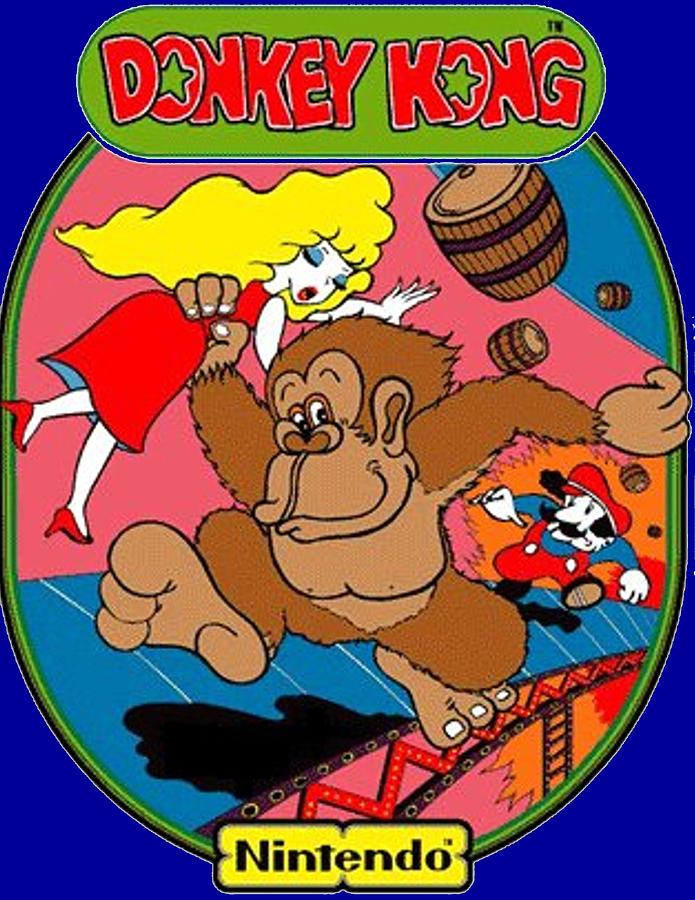Whenever someone, young or old, thinks of video games or video game companies, usually the first thing that comes to mind is either the family-friendly company Nintendo or the man himself, Super Mario.1 But even with the world of video games constantly evolving and changing as time goes on, it’s easy to forget how, back in the days of arcades and other coin machine games, a simple carpenter had the most impact on how we not only design video games, but perceive them as well.2

I want you to imagine this: You’re a newly graduated Arts major in Japan, your fields of interest all revolve around the simple idea of using your creative arts skills to share your ideas with the world through the media of toy making, while also making yourself a handsome income as well. But even back in the 1970s, an Arts degree was still a major cripple in the world of job recruitment, since the majority of employers looking for hired help didn’t see an Arts degree as something worthwhile for their company. That’s the situation Shigeru Miyamoto found himself in when he graduated from the Kanazawa College of Art, as he had ignored his parents’ warnings to not pursue a degree in art, since it was difficult to find a job that would make a substantial income to support him and his family. But Miyamoto stuck to his guns and knew that the creative arts was something he was passionate about. He wanted to pursue the arts as a form of “dream job,” since he was always making all kinds of toys and playing cards in his free time.3
Needless to say, his time in the Kanazawa College of Art was well spent! On top of studying and doing homework, he was also an avid video game player and would find time to play arcade games in his free time. Of course, upon graduating college, things started going south, because his parents were right. Finding a job with an Arts degree was difficult for Miyamoto, especially when he couldn’t find any job that interested him. Fearing the worst, Miyamoto spent the next few years of his life designing, making, and selling all kinds of handmade toys, in an attempt to support himself financially; but it was all disheartening, not only for his parents, but also for himself as well.4

It wasn’t until a few years of unemployment later that Miyamoto’s father introduced him to an old friend of his: the then-president of Nintendo Hiroshi Yamauchi. In the early-to-mid 1970s, Nintendo was nothing more than a simple toy company that sold card games and other toys marketed towards children, and it was because of this that Miyamoto’s father introduced him to Yamauchi, giving him a few samples of the various toys, cards, and other forms of artistic media his son had made in his spare time. It would be an understatement to say that Mr. Yamauchi was anything short of impressed. He hadn’t seen something this creative before in his life, especially something that came from a recent college graduate! In 1977, Miyamoto was hired to work at Nintendo, though he was only given the position of a simple concept and design artist for Nintendo’s toy, card, and gameboard lines at the time.5
Miyamoto was content with the position he had with the company, and was relieved to know he would be able to support himself by using something he felt passionate about. However, as time progressed and new technological advancements were being created, the people of the world weren’t interested in playing with toys, cards, or board games anymore, especially in Japan. Yamauchi knew this, and feared that his company would be forced into bankruptcy if they didn’t find a way to get themselves back into business. With much at stake but little options left, the president turned to the employee who had only been working at the company for three years, and called him in to discuss the idea of moving the company into the media of video games, since physical games and toys were beginning to die out when put against the competition of things such as computers, arcade games, and even other competing companies as well.6
After being in the company for only three years, Miyamoto was tasked with the heavy burden of creating an entirely new video game from the ground up, with little to nothing to work with in terms of budget and licensing. But at that time Yamauchi and the rest of the staff put their faith in Miyamoto, since they knew how passionate and creative he was in terms of creating his own ideas. It was because of this creativity that they hoped that he alone would be enough to make a game profitable enough to spearhead Nintendo into becoming a video game oriented company to compete with rival companies and keep up with the advancing world of entertainment. Of course, even with Miyamoto’s fierce and unwavering determination, that wasn’t enough to keep him from worrying about the more important details in the video making process, particularly the lack of skilled hands in the field of coding, since Nintendo was a strictly toy-based company at that time and contained very few members who knew coding. Miyamoto and the small team he was given were also under constant stress with the various looming deadlines set in place for key components of the game, to make sure they were on track to distribute the game across Japan. They were even under more stress because they were given the entire budget the company had at that time, which was nothing more than a dwindling and shallow pool of money that Nintendo had left. To make matters worse, competition Nintendo had with longtime rivals Namco and Taito in not only the Japanese market but the American market as well, spelt doom for them, as Namco and Taito had already developed hit titles like Pac-man and Space Invaders, and Miyamoto was actually intimidated to make a game idea of his own because of this (not to mention the company didn’t have enough money to buy licensing for Popeye the Sailor Man, a character Miyamoto wanted to base a game around at first).7

But without much time left to worry about purchasing licenses or about how much of the market was dominated by their competitors, Miyamoto came up with the concept for the classic arcade game Donkey Kong (a name that Miyamoto thought roughly translated to “Stupid Ape” in English). The game itself followed the heroic exploits of Mario, an Italian carpenter, on his quest to save his girlfriend from the escaped gorilla Donkey Kong.8
Development went as smoothly as it could, given the team’s current circumstances. A few mechanics of the game had to be rushed due to deadlines, and the fact that the debt Nintendo had was slowly accumulating as a result of producing the game. It was sink or swim at that point, and dropping the Donkey Kong project would do more harm than good at that point in its development. But after one year—one stress and anxiety filled year—the Donkey Kong arcade game was released across Japan in arcades in almost every major city at that time! Thankfully, despite having fierce competition from games like Space Invaders, Pac-man, and other arcade games developed by their rivals, Donkey Kong ended up being a major success, becoming a popular hit in Japan and reeling in enough profit to start moving the game into the West, where its popularity only succeeded the one it had in Japan.9
Upon hitting major success with Donkey Kong, Nintendo decided to send the game over to the west in hopes of achieving the same level of popularity they achieved in Japan. And much like our eastern friends, the west saw Donkey Kong as one of the most revolutionary games of the era. People from all over the United States flocked to their town’s arcades to push in as many quarters as possible to try and scale the various levels set forth to them by Miyamoto himself. The fever of Donkey Kong in America was so widespread and hyped up that it had created something of a cult almost, bringing together professional arcade players from all across the world to compete for the glorious title of the “King of Kong,” aka the one who had achieved the highest possible Donkey Kong score in the entire world.10
- Musa Aykac,“How Nintendo Revolutionized Gaming,” Online Resources, accessed August 27, 2018. https://www.streetdirectory.com/etoday/how-nintendo-revolutionized-gaming-uocflc.html. ↵
- Jennifer Latson,“How Donkey Kong and Mario changed the world,” Time, June 02, 2015. Accessed September 06, 2018. http://time.com/3901489/donkey-kong-anniversary/. ↵
- Nick Paumgarten, “Master of Play,” The New Yorker, June 19, 2017, accessed September 02, 2018. https://www.newyorker.com/magazine/2010/12/20/master-of-play. ↵
- Funk and Wagnalls New World Encyclopedia, 2017, s.v. “Shigeru Miyamoto.” ↵
- Starmen.net, “Game Credits: Shigeru Miyamoto,” accessed September 22, 2018. http://starmen.net/credits/shigerumiyamoto.php. ↵
- Travis Fahs, “The secret history of Donkey Kong,” Gamasutra, July 06, 2011, accessed September 06, 2018. http://www.gamasutra.com/view/feature/134790/the_secret_history_of_donkey_kong.php. ↵
- Travis Fahs, “The secret history of Donkey Kong,” Gamasutra, July 06, 2011, accessed September 06, 2018. http://www.gamasutra.com/view/feature/134790/the_secret_history_of_donkey_kong.php. ↵
- Funk and Wagnalls New World Encyclopedia, 2017, s.v. “Mario.” ↵
- Travis Fahs, “The secret history of Donkey Kong,” Gamasutra, July 06, 2011, accessed September 06, 2018. http://www.gamasutra.com/view/feature/134790/the_secret_history_of_donkey_kong.php. ↵
- Edler Dennis and Frank Dickmann, “The Impact of 1980s and 1990s Video Games on Multimedia Cartography,” Cartographica, Vol. 52 Issue 2 (2017): 168-177. ↵



86 comments
Jose Fernandez
I really enjoyed reading this article. I am a huge fan of Nintendo and video games in general. I think it is important to know the origin of the things you like. And this article does a great job describing the origins of Nintendo. I can tell a lot of research was done before writing the article and I recommend it to anyone who likes video games!
Damian Jennings
I have heard of Nintendo and I have personally owned one of their products, but I never knew that Miyamoto was an individual who resurrected the companies name and brought it a new life. Come to think of it, I have seen the nintendo switch resurface into the gaming community and make a new name for itself. I commend the open mindedness of Yamauchi for putting trust into Miyamoto, this enabled him to work for his company and lead to the construction of new video games.
Cooper Dubrule
It’s interesting to see the origins of something that has flourished so fast and has advanced extremely far from the beginning. All this progress is thanks to Miyamoto and his contribution to the Nintendo company. I really enjoyed the way this article emphasized the situations that really were turning points for Miyamoto. By doing this, the reader is able to pick up the total commitment Miyamoto had to his aspirations.
Andrea Cabrera
For Miyamoto, it was a significant risk to have Nintendo’s faith at his hands at that time. Video game creators, like him, are bright and talented to be able to make these companies successful worldwide. It was so refreshing to learn about Donkey Kong’s beginnings. My siblings have always been big fans of video games and video games history so I had already a little knowledge about the subject. Congratulations on the fascinating article.
Maisie Favila
Games were a huge part of my childhood, so learning about some of its origins was interesting. Shigeru is one of the many art majors who get belittled for their career choices. He was very inspirational to continue pursuing what you’re passionate about despite the opinion of others, especially family. Without him, popular companies such as the discussion of Nintendo wouldn’t be the same. Overall, this article was well written and was a fun read.
Dylan Sanchez
This story was an absolute delight to read. I LOVED playing donkey kong as a child but I have never ever looked into the history behind the game nor Nintendo as a company. Needless to say, this article made me pull out the old NES and play some Donkey Kong. Fantastic story from start to finish.
Nathan Alba
Growing up playing games such as Donkey Kong it is interesting to see exactly where it came from. To think that it could have been produced in order to save a company makes the idea seem that much more stressful. Nintendo is huge now. Who knows what the case for Nintendo could have been if Miyamoto had never created Donkey Kong. Sometimes you just have to stick to your guns and trust the process and all will work out in the end.
Roman Olivera
I loved this article on a subject that I can relate to as a child who grew up playing Donkey Kong and other Nintendo games that came out around that same time period. The Donkey Kong game is actually known as that the hardest skill game in history, it is very hard to beat or even get a good score. This article really sheds light on a time where the company Nintendo was almost bankrupt and would have not been one of the innovators in the video game revolution.
Jasmine Rocha
Nintendo is a big part of my life and childhood it brought me and my siblings together. I love learning the history of different companies and knowing how Nintendo evolved from a toy company to video games company. Nintendo would have not been who it is without Miyamoto and the game Donkey Kong the first in the best series and game lore with Super Mario. If it was not for Yamauchi hiring Miyamoto and creating the first video game we would have never seen the amazing things that Nintendo has done.
Emily Jensen
I really enjoyed this article. My brother and I always played Nintendo games when we were little, so it was nice to read some of the history behind the company. I wonder if Miyamoto and his team ever thought game that they were working on would be such a huge hit. Donkey Kong will remain a classic game for generations to come.